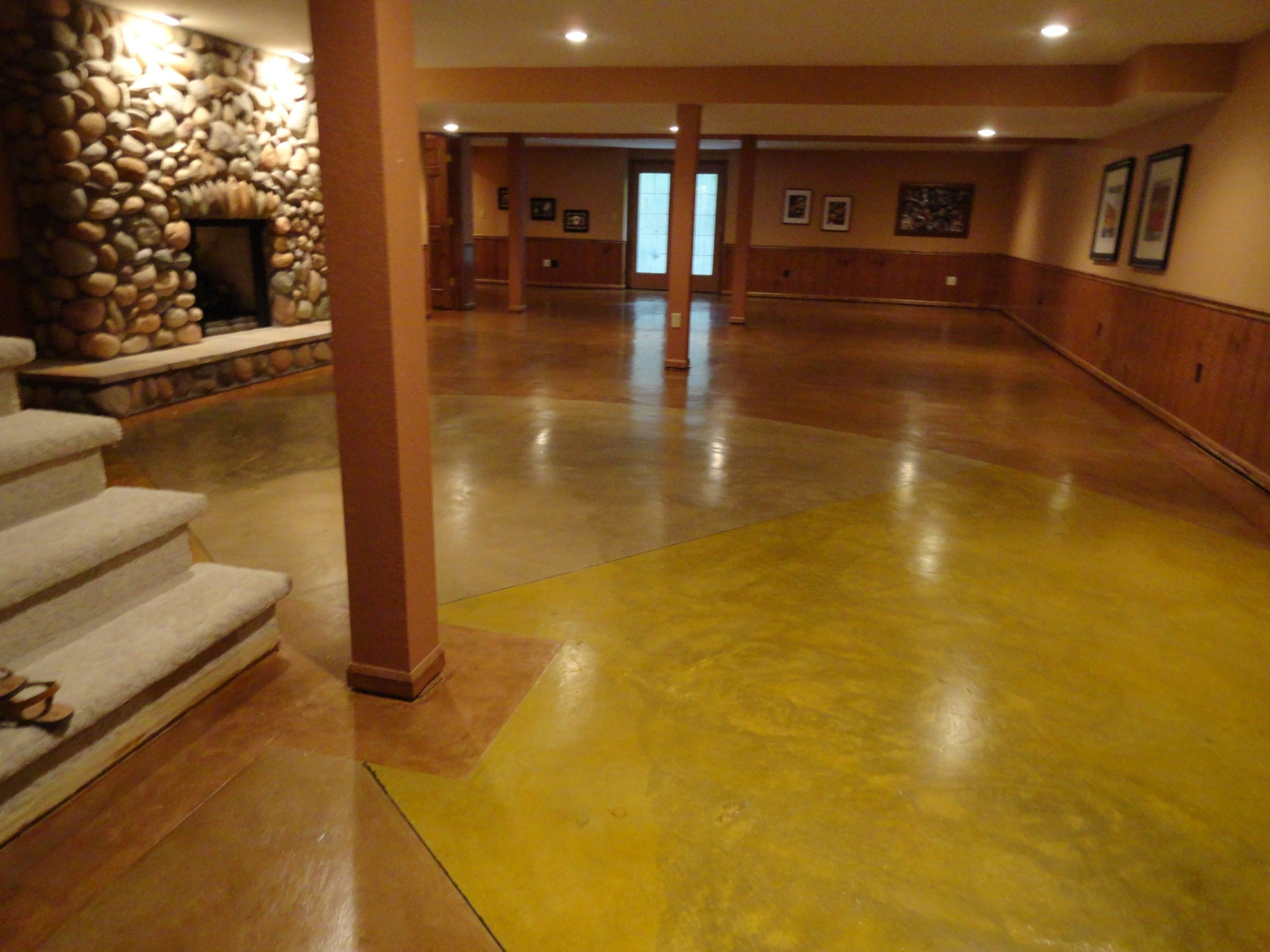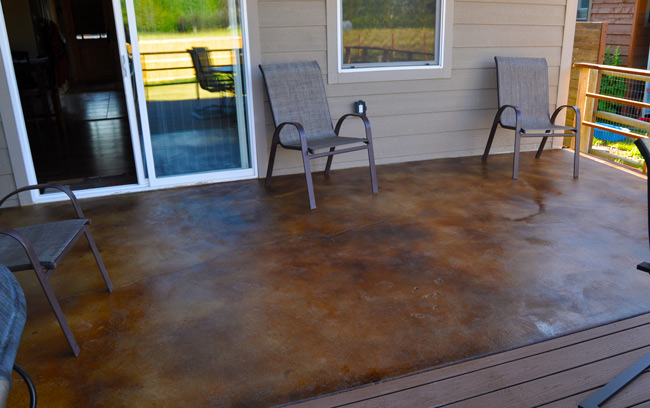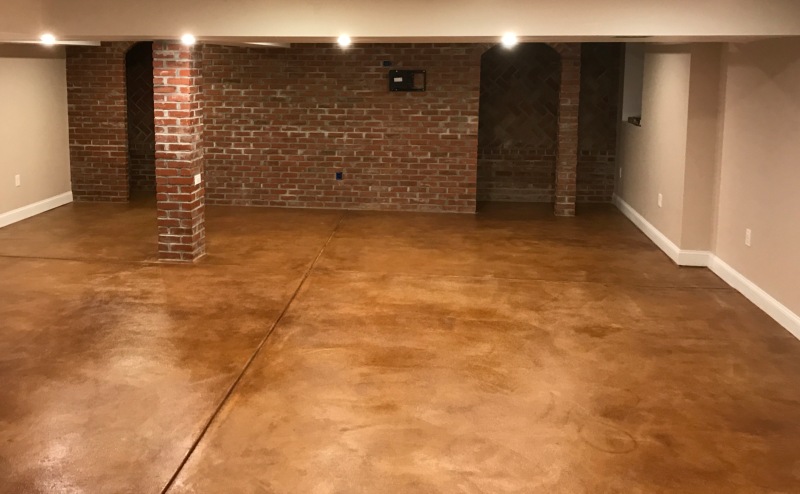Everything About Stained Concrete: A Comprehensive Overview to Its Advantages and Applications
Stained concrete has actually become a prominent option for both property and commercial rooms. Its capacity to incorporate visual charm with practicality makes it a fascinating option. Various staining methods use a variety of shades and finishes, permitting customization. The advantages expand past appearance. Understanding its applications and maintenance requirements is important for any individual considering this versatile material. The nuances of stained concrete invite better expedition.
What Is Stained Concrete?

Staining can be put on various surfaces, including floorings, driveways, and patios, making it a flexible option for both interior and outside areas. The treatment can accomplish a series of appearances, from natural tones to strong, modern-day layouts. Unlike paint, stained concrete maintains its appearance in time, as it becomes an essential component of the concrete itself. Generally, stained concrete functions as an effective method for changing regular concrete right into aesthetically striking surface areas.
Benefits of Stained Concrete
Stained concrete offers considerable advantages, particularly in aesthetic appeal and resilience - stained concrete. Its dynamic colors and one-of-a-kind patterns enhance the visual charm of any room, making it a prominent choice for both household and commercial applications. In addition, the long life of stained concrete assurances that it remains a sensible financial investment gradually, withstanding damage
Visual Allure
One of one of the most compelling benefits of making use of stained concrete is its exceptional aesthetic allure. Stained concrete offers an one-of-a-kind and flexible look that can match numerous design styles, from modern-day to rustic. The infusion of vivid shades and complex patterns allows property owners and developers to produce customized surface areas that can improve the total atmosphere of a space. Unlike standard floor covering alternatives, stained concrete can resemble the appearance of all-natural stone or polished marble, supplying an upscale appearance without the connected costs. Furthermore, the shiny surface choices can reflect light, more lightening up insides. This flexibility makes stained concrete a favored selection for both property and industrial applications, where aesthetic effect is paramount.
Resilience and Long life
The impressive visual qualities of stained concrete are matched by its exceptional sturdiness and long life - stained concrete floors. Stained concrete surface areas are resistant to put on and tear, making them appropriate for high-traffic areas both inside and outdoors. Their robust nature indicates they can hold up against extreme climate condition, including extreme temperatures, rain, and UV direct exposure, without substantial destruction. On top of that, stained concrete requires marginal maintenance contrasted to other flooring alternatives, as it does not require frequent sealing or redecorating. This longevity not only decreases replacement prices but additionally contributes to a lasting structure method. Generally, stained concrete provides an enduring service that combines visual charm with sensible benefits, ensuring its worth over time
Various Kinds Of Staining Methods
Different staining techniques can substantially influence the aesthetic qualities of concrete surfaces. The three main techniques include acid staining, which reacts chemically with the concrete, water-based staining, which supplies a more comprehensive series of colors, and overlay discoloration alternatives that offer a fresh surface. Each method has special qualities and applications that satisfy different design preferences and task demands.
Acid Discoloration Method
Just how can house owners change plain concrete surface areas right into aesthetically striking functions? One reliable approach is acid staining, a prominent strategy that improves the all-natural appeal of concrete. This procedure involves applying an option of water, hydrochloric acid, and metallic salts to the concrete surface. As the acid responds with the lime present in the concrete, it creates abundant, variegated shades that resemble marble or rock. Acid discoloration is known for its sturdiness and resistance to fading, making it a long-lasting selection for both indoor and outdoor applications. It is necessary to note that the outcomes can differ based on the initial concrete color and texture. Proper application and securing are vital for accomplishing the wanted visual and longevity
Water-Based Discoloration Technique
A preferred option to acid discoloration, the water-based discoloration method offers home owners a versatile way to improve concrete surface areas. This method uses water-soluble dyes and pigments, enabling a variety of colors and surfaces. Unlike acid spots, water-based spots can be related to unsealed concrete and provide a much easier cleanup process. The outcomes can achieve a much more uniform appearance and can be layered to create unique effects. Furthermore, water-based spots are typically less toxic and produce less unstable organic compounds (VOCs), making them more eco-friendly. Property owners might appreciate the ability to customize great post to read their concrete surface areas with different tones, enabling innovative expression while maintaining toughness and longevity in their flooring selections.
Overlay Staining Options
Numerous overlay discoloration options exist for house owners aiming to invigorate their concrete surfaces. One popular choice is acid discoloration, which reacts chemically with the concrete to create abundant, variegated colors. Another option is water-based staining, using a broader color combination and easier application. Furthermore, concrete overlays can be combined with stencils for detailed styles, boosting aesthetic appeals. For an extra textured surface, house owners might take into consideration utilizing stamped overlays that simulate natural materials like stone or ceramic tile. Each technique offers special advantages, from toughness to customization, enabling a personalized touch. Inevitably, the choice of overlay discoloration relies on the desired look and the problem of the existing concrete, ensuring a refreshed and enticing surface.
Applications of Stained Concrete
Stained concrete deals a flexible option for various applications, enhancing both aesthetic appeal and functionality. This product is commonly used in domestic, commercial, and industrial settings, making it a prominent option among architects and developers. In homes, stained concrete can serve as elegant floor covering or outside patios, offering a sophisticated look while continuing to be long lasting.
In industrial areas, such as retail shops and dining establishments, stained concrete adds to a contemporary setting and can hold up against heavy foot web traffic. Additionally, stained concrete is progressively used in public spaces like parks and walkways, where its ability to simulate all-natural stone or various other products includes aesthetic interest.
Additionally, stained concrete is ideal for pool decks and driveways, providing a slip-resistant surface that is simple to keep. On the whole, the versatility of stained concrete makes it suitable for various environments, accommodating varied tastes and needs.
Upkeep and Look After Stained Concrete
Proper maintenance assures Learn More the durability and beauty of stained concrete surface areas. Routine cleaning is essential; making use of a mild cleaning agent and water with a soft-bristle brush helps remove dirt and grime without damaging the coating. It is advisable to stay clear of rough chemicals that can remove away the discolor or sealer.
Securing stained concrete is essential for protection versus moisture, discolorations, and wear. A high-grade sealant must be reapplied each to three years, depending on the website traffic and exposure the surface sustains. Furthermore, attending to spills without delay will protect against discoloration and discoloration.

Price Factors To Consider for Stained Concrete Projects
When preparing a stained concrete project, budget considerations play an important role in figuring out the overall price. The costs connected with stained concrete can differ substantially based upon a number of elements. Initially, the size of the area to be stained directly affects product and labor prices. Larger spaces will naturally require more resources. Second, the kind of tarnish chosen-- acid-based or water-based-- can influence rates, with acid stains frequently being extra pricey. In addition, the complexity of the layout, consisting of patterns or multiple shades, can increase labor costs. Preparation job, such as cleansing and grinding the concrete surface area, includes to the initial expenses. The choice in between Do it yourself installment and working with an expert specialist will better impact the budget plan. Comprehending these variables makes it possible for homeowners to make educated economic choices concerning their stained concrete jobs, guaranteeing they achieve the preferred aesthetic within their financial ways.
Tips for Choosing the Right Stained Concrete for Your Area
Picking the ideal stained concrete for a particular space includes cautious consideration of various elements past just budget. One ought to evaluate the desired use of the area. High-traffic zones may require even more sturdy surfaces, while decorative applications can prioritize looks.
The shade palette is another vital element; the selected colors must harmonize with existing design and illumination. It's also crucial to take into consideration the surface area texture, as smooth coatings can enhance sophistication, while textured options might ensure safety in damp locations.
Local environment and ecological problems play a considerable function in the long life and upkeep of stained concrete, affecting the selection of sealants and surfaces.
Ultimately, speaking with experts can provide useful understandings tailored to particular needs, guaranteeing the choice of the excellent stained concrete that aligns with both capability and style.

Regularly Asked Concerns
Can Stained Concrete Be Applied Over Existing Floor Covering?
Stained concrete can undoubtedly be used over existing floor covering, supplied the surface is secure and properly prepared. This technique permits an aesthetic upgrade without the requirement for full elimination of the initial floor covering materials.
How Long Does Stained Concrete Last?
Stained concrete can last for decades when effectively kept. Elements such as traffic, environmental problems, and application strategies considerably influence its longevity, with lots of installations continuing to be dynamic and undamaged for 10 to 30 years.
Is Stained Concrete Slippery When Damp?
Stained concrete can be unsafe when wet, as the surface might produce a smooth surface. Nonetheless, making use of non-slip additives or textured surfaces can minimize this issue, improving safety and security without jeopardizing the aesthetic appeal of the concrete.
Can I Tarnish Concrete Myself, or Should I Work with a Specialist?
The decision to stain concrete personally or hire a professional rest on skill level and project intricacy. While do it yourself staining can conserve cash, specialists assure perfect outcomes, especially for detailed styles or large surface areas.
What Color styles Are Offered for Stained Concrete?
The selection of colors readily available for stained concrete consists of natural discover this info here tones like browns and tans, lively shades such as reds and blues, and softer hues like pastels. This combination permits creative, personalized design choices.